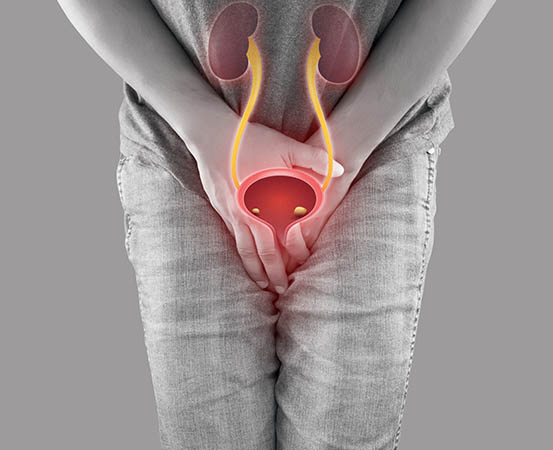
Urinary incontinence is a urinary condition wherein an individual cannot control or hold urine to pass due to an overactive bladder (OAB). Many do not talk about this condition nor its symptoms as they feel embarrassed. It often goes unnoticed and is difficult to treat later. However, experts say that this condition is seen in those above 40 years of age and can be treated in many ways, even without medications.
This condition can be seen in individuals who have urological injuries or children or even young adults who have abnormality in the bladder, says Dr Srinivas AK, consultant urologist and general surgeon, Kauvery Hospital Bangalore. He also said that this condition is seen in women who have menopausal or postmenopausal stages.
What are the causes of urinary incontinence?
Dr Srinivas says, “There are basically three types of incontinence, one is urgent incontinence where individuals face urgency to urinate and then they start leaking urine; the second type is called stress incontinence, which occurs when coughing or sneezing. It can cause leakage of urine and the third category includes a mixture of both types, also known as mixed urinary incontinence.”
He adds, “In men, the usual causes for incontinence are smoking, excessive coffee, tea intake, inadequate water intake, anxiety, and prostate problems.”
According to Dr Sunitha Lobo, consultant gynecologist, Fortis Bangalore, urinary tract infections, pregnancy, beverages like alcohol, constipation and medications like anti-depressants and diuretics (help release more sodium into urine) can cause temporary or short-term urinary incontinence.
READ MORE:
All you need to know about excess uric acid
What urine tells about your health
Glycosuria: a warning bell for the kidneys
Chronic or long-term causes of incontinence include pelvic floor disorders, dropped bladder (bladder bulges into vaginal space), stroke, diabetes, and menopause. Dr Lobo emphasizes that urinary incontinence is most seen in pregnant and menopausal women.
“During pregnancy, the growing baby squishes your bladder, increasing the feeling of urge to pee. Pelvic floor muscles also weaken as your uterus expands, especially towards the end of pregnancy when the baby has grown large. This leads to Stress Urinary Incontinence (SUI) that causes a leaky bladder in pregnant women during exercise, walking, bending, lifting, or even sneezing and coughing. It can be a few drops of urine to a tablespoon or more. SUI can be mild, moderate, or severe,” she added.
Types of urinary incontinence
Dr Shekhar Sathaye, chief of urology, Institute of Kidney Diseases and Research Centre (IKDRC), Ahmedabad says, that there are different types of urinary incontinence based on the cause:
- Urge incontinence caused by an OAB
- Stress incontinence caused due to pregnancy
- Overflow incontinence caused if bladder isn’t emptied each time you urinate or having a too-full bladder
- Temporary incontinence due to an infection or new medication.
- Mixed incontinence caused due to both stress incontinence and OAB
Tests to detect urinary incontinence
A few tests that can detect this condition are:
- Physical examination
- Routine urine culture
- Ultrasonography
- Stress test
- Cystoscopy or urodynamic testing
How to treat urinary incontinence
The experts chose treatment based on the type of incontinence, hence determining the root cause is of primary importance.
Medical interventions
- Checking of medical history
- Prescribed medications
- Surgical treatments
- Using pads or other products for reduced leakage
- An artificial urethral sphincter placed to close the urethra when not urinating (used commonly after prostate surgery in men)
- An indwelling catheter (catheter inserted into urethra to drain urine into a bag outside the body)
- Vaginal creams which contain estrogen
Natural ways
Diet: Reducing the coffee intake, avoiding bladder stimulants, reducing intake of alcoholic beverages or non-alcoholic beverages like Pepsi, and Coca-Cola. Increasing the consumption of food rich in dietary fiber and including probiotics rich in calcium can help. Foods that can help to avoid constipation should be taken. Target for moderate fluid intake, avoid excessive intake. Reduce salt intake through cooked food and keep a check on sugar intake. Individuals are advised to eat seasonal and regional fruits with a lot of antioxidants. Citrus fruits and vegetables should be consumed. Overall, a low-calorie, low-spicy and low-sugary diet is recommended.
Lifestyle: Physical activities and leading an active lifestyle can be of immense help. Individuals should aim for the maintenance of body weight. It is required to empty the bladder at regular intervals or before physical activity.
Exercises: Strengthening pelvic floor muscles with exercise like Kegel exercises can immensely contribute to the treatment of bladder incontinence. There is an advanced technique of Biofeedback wherein it can be checked that the individual is doing the exercises properly by placing sensors the rectum and asking them to squeeze or do the pelvic floor exercise.
Dr Srinivas says, “Leakage issues should prompt a visit to a urologist for consultation, with 99% of cases treatable early through conservative management, often without medication. Exercises typically take 2-3 months to show effectiveness, comparable to medication. After this period, medication can be withdrawn, and individuals can continue with exercises, gradually reducing before stopping completely. Continuing exercises for 3-6 months is recommended, after which individuals can follow up with their specialists if symptoms have improved and decide whether to reduce frequency or stop altogether.”
Takeaways
- Urinary incontinence is a condition where a person cannot control their urge to urinate.
- Various tests such as physical examination, urine test, stress test and cystoscopy can be used to detect urinary incontinence.
- In several cases, conservative treatments and natural ways like pelvic floor exercises, balanced diet and active lifestyle can help treat urinary incontinence even without medical interventions.

















